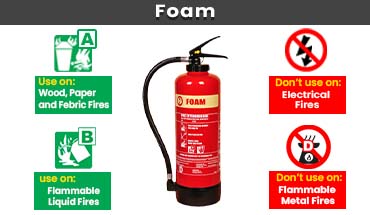
Fire extinguishers are portable devices designed to suppress small fires or control them until professional help arrives. It works by expelling a substance, such as water, foam, dry chemical, or carbon dioxide, interrupting the chemical reaction causing the fire.
Types of Fire Extinguishers
Water Extinguishers
Spread the jet of water on the hot materials.
Don’t use electrical equipment.

Foam Extinguishers
It is suitable for liquid fires like petrol or diesel and is also used in solids such as wood and paper.

Powder Extinguishers
It is Suitable for electrical equipment such as Switch boxes, cables, etc.Powder extinguishers are not recommended for use inside the buildings. Because it creates a loss of visibility & breathing problems.

Carbon Dioxide Extinguishers(CO2)
CO2 extinguishers are ideal for places with a lot of electrical equipment such as offices, server rooms, and electrical rooms. It can also extinguish liquid fires arising from petrol or diesel.

What Are The 5 Different Classes of Fire?
There are several types of fire extinguishers, such as Class A, Class B, Class C, Class D, and Class K. Any individual who uses fire-fighting equipment should be trained on how to use &execute fire-fighting techniques. It is essential to use the correct type of fire extinguisher for the type of fire that may occur. It should also be inspected regularly and recharged or replaced as necessary to ensure they are in proper working condition.
How to Use a Fire Extinguisher?
Knowing how to use a fire extinguisher in an emergency can be very helpful. The following are the basic steps to use a fire extinguisher
1. Choose The Suitable Fire Extinguisher
- Class A fires involving ordinary combustibles such as wood, paper, or cloth.
- Class B: fires involving flammable liquids such as gasoline, oil, or paint.
- Class C: fires involving electrical equipment such as appliances, wiring, or circuit breakers. (Don’t use water on this type of fire, you’ll get electrocuted!)
- Class D: fires involving flammable metals such as magnesium or titanium.
- Class K: Oils and grease fires. (Never use water on a grease fire it will cause the flames to explode and spread)
Check the label on the extinguisher to determine which type of fire it can be used on. The label includes symbols indicating which fire the extinguisher is designed to fight. A circle and a red slash through any of the symbols indicate that the extinguisher cannot be used to fight that type of fire.
2. Evaluate The Situation
- Before using a fire extinguisher, make sure that the fire is small and contained. If the fire is large or spreading quickly instruct someone to call the fire department or call them yourself.
- If you can extinguish the fire on your own, it’s best to have the fire department on the way in case something happens.
- When the fire department arrives, they can check that the fire has been extinguished properly and they proceed further steps to avoid fire.
3. Identify a Safe Evacuation Path Before Approaching a Fire
- Make sure that you have a clear evacuation route before using a fire extinguisher. If you cannot extinguish the fire, you’ll need to make a safe exit.
- When you decide where to store your fire extinguisher, check that you’ll have multiple exit options nearby after you get it.
4. Stay Away from Fire
- Face the fire and keep your back to the clear exit you identified earlier while orienting your head towards the fire.
- You should stay between 6 to 8 feet (1.8 to 2.4 m) (1.8 to 2.4 m) away from the flames as you prepare to operate the fire extinguisher.
5. Use The P.A.S.S Technique
It’s hard to think clearly during an emergency, PASS techniques make you remember how to operate your fire extinguisher.
Pull extinguishers have pins inserted into the handle to prevent accidental discharge. Just grab the ring and pull the pin out and unlocks the extinguisher.

Aim the hose at the base fire, Hold the lower handle lever in hand,grab the hose or nozzle in other hand. Point the hose at the base of fire to extinguish burning fuel.

Squeeze the two levers together with one hand, and point the hose at the fire’s base with the other hand to release the extinguishing agent. Squeeze the levers slowly and evenly.

Sweep from side to side and move the nozzle back and forth until the fire is out.
Keep a safe distance from the fire and keep spraying until the flames are extinguished.

6.Observe Closely
After the flames go out, keep an eye on the fire area to make sure it doesn’t reignite. If the fire starts again, repeat the PASS techniques.
7. Get To a Safe Place
If the fire has been extinguished, or if you are not able to do so, you must leave the scene and find a place where you are not in direct contact with the fire.
Common Mistakes to Avoid Using Fire Extinguishers
- Read the operating instructions that came with your fire extinguisher carefully
- Never use a fire extinguisher for a class of fire that is not indicated on the label.
- Be aware of the expiration date of the fire extinguisher and replace them as needed.
- Make sure your extinguisher’s pressure needle is in the green zone. When it drops to the red zone and cannot release the extinguishing agent, it must be recharged immediately.
- Fire extinguishers in the workplace are to be recharged or tested every 6 years.
- Place the fire extinguisher in an easily accessible location near exterior doors.
- Display the evacuation routes clearly in everyone’s sight.
What Next?
The best way to keep your workplace safe in the event of a fire is, Your employees must be provided proper fire-fighting training to ensure safety. Need Assistance? Feel Free to contact us….

